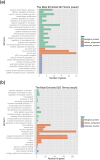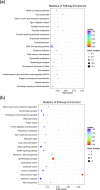Discovery of exercise-related genes and pathway analysis based on comparative genomes of Mongolian originated Abaga and Wushen horse
- PMID: 36249530
- PMCID: PMC9518662
- DOI: 10.1515/biol-2022-0487
Discovery of exercise-related genes and pathway analysis based on comparative genomes of Mongolian originated Abaga and Wushen horse
Abstract
The Mongolian horses have excellent endurance and stress resistance to adapt to the cold and harsh plateau conditions. Intraspecific genetic diversity is mainly embodied in various genetic advantages of different branches of the Mongolian horse. Since people pay progressive attention to the athletic performance of horse, we expect to guide the exercise-oriented breeding of horses through genomics research. We obtained the clean data of 630,535,376,400 bp through the entire genome second-generation sequencing for the whole blood of four Abaga horses and ten Wushen horses. Based on the data analysis of single nucleotide polymorphism, we severally detected that 479 and 943 positively selected genes, particularly exercise related, were mainly enriched on equine chromosome 4 in Abaga horses and Wushen horses, which implied that chromosome 4 may be associated with the evolution of the Mongolian horse and athletic performance. Four hundred and forty genes of positive selection were enriched in 12 exercise-related pathways and narrowed in 21 exercise-related genes in Abaga horse, which were distinguished from Wushen horse. So, we speculated that the Abaga horse may have oriented genes for the motorial mechanism and 21 exercise-related genes also provided a molecular genetic basis for exercise-directed breeding of the Mongolian horse.
Keywords: Mongolian horse; athletic performance; exercise; genome.
© 2022 Jing Pan et al., published by De Gruyter.
Conflict of interest statement
Conflict of interest: Authors state no conflict of interest.
Figures






Similar articles
-
Chinese Mongolian horses may retain early domestic male genetic lineages yet to be discovered.Anim Genet. 2019 Aug;50(4):399-402. doi: 10.1111/age.12780. Epub 2019 May 9. Anim Genet. 2019. PMID: 31073991
-
Selection signatures for local and regional adaptation in Chinese Mongolian horse breeds reveal candidate genes for hoof health.BMC Genomics. 2023 Jan 19;24(1):35. doi: 10.1186/s12864-023-09116-8. BMC Genomics. 2023. PMID: 36658473 Free PMC article.
-
Physiological and Metabolic Responses of Mongolian Horses to a 20 km Endurance Exercise and Screening for New Oxidative-Imbalance Biomarkers.Animals (Basel). 2025 May 7;15(9):1350. doi: 10.3390/ani15091350. Animals (Basel). 2025. PMID: 40362165 Free PMC article.
-
[Progress in the study of genetic diversity of Mongolian horse].Yi Chuan. 2008 Mar;30(3):269-76. Yi Chuan. 2008. PMID: 18331992 Review. Chinese.
-
Candidate genes for physical performance in the horse.Vet J. 2011 Oct;190(1):39-48. doi: 10.1016/j.tvjl.2010.09.029. Epub 2010 Nov 5. Vet J. 2011. PMID: 21115378 Review.
Cited by
-
The Characteristics, Distribution, Function, and Origin of Alternative Lateral Horse Gaits.Animals (Basel). 2023 Aug 8;13(16):2557. doi: 10.3390/ani13162557. Animals (Basel). 2023. PMID: 37627349 Free PMC article. Review.
-
Regulatory Mechanisms of Yili Horses During an 80 km Race Based on Transcriptomics and Metabolomics Analyses.Int J Mol Sci. 2025 Mar 8;26(6):2426. doi: 10.3390/ijms26062426. Int J Mol Sci. 2025. PMID: 40141070 Free PMC article.
References
-
- Chang H, Han GC, Mao YJ, Bai DQ, Dugarjaviin M, Sun W et al. Animal genetic resources in China: horse, donkeys, camels. Beijing: China Agriculture Press; 2011. p. 28–37.
-
- Gim JA, Ayarpadikannan S, Eo J, Kwon YJ, Choi Y, Lee HK, et al. Transcriptional expression changes of glucose metabolism genes after exercise in thoroughbred horses. Gene. 2014;547:152–8. - PubMed
LinkOut - more resources
Full Text Sources
